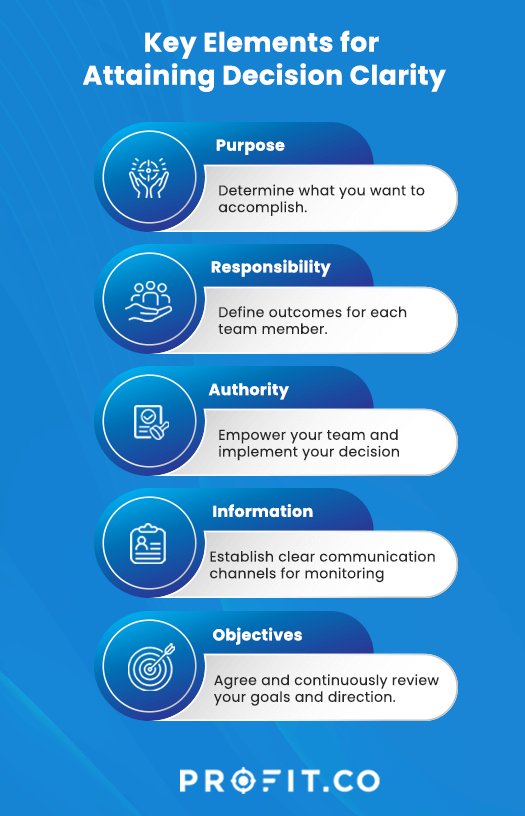Introduction
Making the correct decisions can be intimidating in everyday life, especially regarding business.
Business decisions involve numerous data points, team feedback, and leaders’ preferences and biases. Business leaders can fall victim to the availability heuristic bias instead of taking actionable steps to attain understanding. The only way to achieve decision clarity is to rely on facts to make the right choices and confront biases.
This guide to improving business decisions with data-driven decision-making strategies will guide you toward making decisions confidently.
What is Data-Driven Decision-Making?
Data-driven decision-making (DDDM) means relying on data from your key performance indicators (KPIs) to make choices. It involves interpreting your business intelligence data into actionable insights and eliminating emotions and biases from your decisions. Therefore, all your business choices rely on evidence rather than preference or opinion.
Examples of Data-Driven Decision Making
As long as a business generates operational data, it can use DDDM to inform its strategy.
Some examples of data-driven decision-making include:
- Using customer metrics to offer product recommendations on an e-commerce platform
- Using historical data to assess borrower risk before approving loans
- Using audience demographics to target advertisements, offers, and value-adds
- Using occupational health and safety data to improve manufacturing processes and implement safety policies
Remember to consult your data before making your choices rather than using data to confirm your choices. Anchoring bias in decision-making and injecting biases into data is easy, so take steps to prevent this from happening. Begin with setting measurable goals, choosing suitable data sources, and organizing your data in a dashboard for easy visualization and sharing.
You are defined not just by your capablities, but by the choice you make.
What is Decision Clarity?
Once you gather data for decision-making, the next challenge is to find clarity in that data to inspire a confident choice. Decision clarity means assessing all relevant data using analysis tools to discover the best way forward.
Your decision clarity and insights must answer the following questions:
- What is your decision-making rationale?
- What factors will impact your decision?
- How will you evaluate and address each issue arising from the decision?
Answer these fundamental questions using your business data for maximum decision clarity.
Why Do You Need Decision Clarity?
Business leaders and managers are increasingly frustrated with decision-making. That’s why decision clarity and insights are critical to successful management.
Decision clarity enables a business to:
1. Save time
Instead of taking weeks or months to decide, you can focus on relevant data to chart a course without unnecessary steps.
2. Take action
A clear decision eliminates uncertainty and redirects your focus to implementation.
3. Maintain agility
A clear decision allows you to be flexible and adapt your strategy to meet your overall business goals.
Want to stay ahead of the competition? Start tracking your KPIs and make data-driven decisions!
What Are the Key Elements for Attaining Decision Clarity?
Decision clarity and insights rely on five essential elements that comprise the circle of clarity.
The key elements for attaining decision clarity are:
1. Purpose
Determine what you want your decision to accomplish, e.g., improving customer experience, streamlining operations, improving communication, etc.
2. Responsibility
Describe the particular outcome for each team member, including the core tasks to perform to implement the decision. Always make room for unknown tasks or decisions your team may need to make over time.
3. Authority
Next, empower your team to make subsequent choices and use resources to implement your overall decision. Give team leaders the responsibility, freedom, and authority to determine the best action.
4. Information
Establish clear communication channels throughout implementation to monitor progress and solve problems as they arise. Identify which data is most valuable to implement your decision, who needs that data, and where to find it.
5. Objectives
Agree on your goals and direction, reviewing them often as your decision impacts your business outcomes. Also, accommodate your team’s contributions in your decision-making process to get the buy-in necessary to implement your strategy.

Do’s and Don’ts in Decision Making
Organizational decision-making faces numerous challenges, from managing risk to confronting biases.
To reduce the complexity of decision-making, consider the following do’s and don’ts for decision clarity:
- Do: prioritize critical, game-changing decisions that directly impact your business strategy.
- Don’t: call for a meeting to make every decision. Instead, schedule meetings for the most critical decisions and use reports or written updates for minor decisions.
- Do: identify the essential decision makers and outline their roles.
- Don’t: micromanage when delegating decisions. Instead, create a safe work environment that acknowledges mistakes and encourages learning.
Successful Strategy for Great Decision-Making
It’s up to business leaders to establish a decision-making strategy to guide managers and teams through uncertainties. Strategy implementation is a necessary process for making the correct business decisions.
Here are five techniques to consider for decision clarity and insights:
- Think of decision-making as a process, not an event. Follow a structured step-by-step approach that you can repeat for different decisions.
- Engage your team in understanding insights instead of relying on management alone. This way, you can leverage collective knowledge and innovate solutions.
- Encourage collaboration, inquiry, and diversity in decision-making. Empowered teams yield better decisions.
- Establish psychological safety in the workplace to welcome everyone’s opinions, create trust, and actively listen to suggestions that foster decision clarity.
- Stay focused on your decision-making purpose and goals. Reiterate the decision and demonstrate how everyone’s contribution drives the company forward.
What Are the Types of Insights in Data-Driven Decision Making?
Actionable insights come from analytics, meaning a systematic business data assessment. This assessment lets you determine the correct data to influence your business decisions, further enabling decision-making across organizational levels.
The main types of actionable insights are:
- Descriptive analytics, which indicates your past business performance
- Predictive analytics, which can predict future business performance
- Diagnostic analytics, which explains events, e.g., the reasons behind increased customer complaints
- Prescriptive analytics uses current and historical data to inform future business decisions
For example, you can utilize your sales data in your last quarter to analyze customer trends, set prices, improve marketing goals, and adapt to competitor activity.
How Do Actionable Decisions Help You Attain Decision Clarity?
You must derive decision clarity once you gather your business data, run them through analytics, and get actionable insights.
Decision clarity and insights work together to make the following choices:
- Long-term decisions that integrate into your core business strategy and operations
- Short-term decisions based on predictive data to tweak your business strategy
- Decision validation, meaning that your insights confirm your choices, and there’s no need for further action
- Strategy testing or using insights to check whether your business strategy works as intended or needs to change
Whichever choice you make, you will have reliable data to inform your decision-making process. If your decision’s outcomes don’t match expectations, analyze your business data to find opportunities for improvement.
FAQs
1. What is decision clarity?
Decision clarity means making sound business choices based on relevant, accurate data insights.
2. What are the insights for decision-making?
Decision-making insights come from thorough, systematic business data analysis to inform and guide organizational choices.
3. Why do we need clarity in decision-making?
The clarity in decision-making enables us to save time, eliminate uncertainty, and adapt our strategies to meet goals and objectives.
Conclusion
Decision clarity & insights enable business leaders to make confident choices that inspire better performance and team morale. You don’t have to be a trained data scientist or expert to leverage business data.
Use business intelligence tools such as Profit.co’s software with user-friendly dashboards and report-generation features for understanding insights and attaining clarity. Using a great intuitive OKR software can increase your familiarity with your business data and improve your decision-making process.

